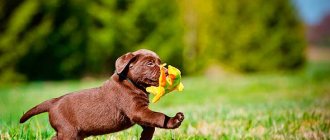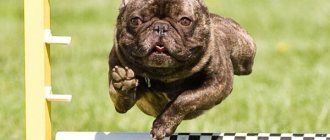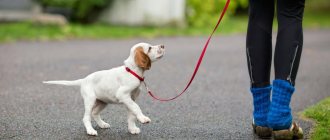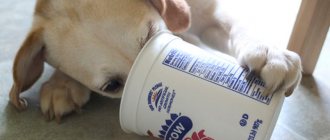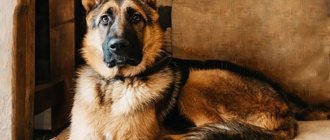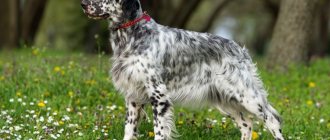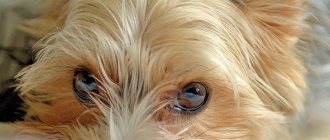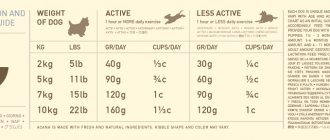First of all, you need to teach the puppy to quickly respond to its name. At the first stage, watch how this skill is developed. It is necessary to gradually reduce the number of incentives. Use them only to mark the puppy’s quick and clear reaction to its name. When the puppy begins to respond effectively to the name, begin the second stage. Give encouragement if you notice that the reaction is weakening. When the puppy is 2 months old, you can begin to carefully, without causing pain, accustom your baby to a leash and harness.
First stage : training to use a harness. It must match the size of the puppy. Be careful when putting on the harness, but act quickly. Let the puppy run freely. Is your baby worried? Start a game, a run. This will distract the dog. Is the puppy behaving well? Praise him, pet him, give him a treat.
At the second stage, the puppy is accustomed to a leash. You need a light leash with a light carabiner, the width of the leash is 1 cm, the length is from 1.5 to 2 m. Your task: attach the leash to the harness and lower it to the floor. Control the situation: the leash should not cling to anything. Start by keeping your puppy on a leash for 20 minutes.
At the third stage , take the leash in your hands to walk with the puppy. Does the puppy pull to the side or stop? Say the nickname, then command “Let's go.” Is the puppy stubborn? Engage him with a treat or toy. For good behavior, “reward” the dog with stroking, praise, and treats.
Remember : the leash cannot be used for punishment so that the puppy is not afraid of it. You should not allow the dog to pull the leash with its teeth or chew it - the leash is not a toy, but a training tool.
The puppy and the external environment: when and how to “get acquainted”
The main thing is that by this time a strong contact has been established between the dog and the owner. Small puppies are very vulnerable and susceptible if they encounter harsh stimuli. At first you need to protect your dog from them. Choose quiet places for walks, where there are no adult dogs, and walk for a short time. Remember that the puppy has not yet completed the full course of vaccinations, so he must walk in a basket or in your arms.
But the puppy can still be afraid of something. If this happens, switch his attention to the toy and move away from the frightening object. Wait a little and return to the source of fear again. This way the puppy will understand that there is no danger.
Good puppy feeding: basic points
When choosing the type of dog food (dry food or natural food), follow the rule - do not overfeed! Overeating can have serious consequences. It’s not worth growing your pet’s stomach to a large size; overfeeding will lead to poor health, joint problems, which is especially important for large breed dogs), and diseases of the internal organs.
When can you feed puppies? Before bedtime, if the dog is hungry. Offer your pet milk porridge, pamper it with meat, but do not make the ritual daily.
Feeding the puppy natural food
Many owners choose how to feed their dogs natural products. The reasons for choosing are as follows:
- natural food is cheaper than buying ready-made food;
- natural food gives confidence in the quality of food.
There are also a lot of disadvantages to feeding “human” food: you have to often go to the store and prepare food, because during the growth period the animal eats a lot.
The main motto is “Only natural”, isn’t the prospect of standing near the stove for a long time scary? We recommend paying attention to the freshness of the products. Meat that tastes good at a low price will play a cruel joke on the health of an eared baby. Poisoning from low-quality products is not uncommon. Remember that a puppy is a small child, so it is important to take food responsibly.
Second rule: you cannot feed your dog from the table! Signature aromatic borscht, seasoned with sour cream, cabbage rolls prepared according to a family recipe will appeal to people, but not to the puppy, and will cause problems with his well-being!
What can you feed your little friend?
1) Milk
A puppy's diet up to 4 months includes milk. This product provides vital elements for the growth and development of a foolish baby. Offer it raw and cook milk porridge. Not every milk will do. Choose goat, you can’t go wrong - there are rarely allergies to it, and it is easier to accept by the body. Having trouble finding a goat? You can give cow's milk, but dilute it with water to avoid intestinal upset.
Closer to six months, the amount of milk is reduced and gradually eliminated, replacing it with fermented milk products.
2) Dairy products
Proper feeding of puppies consists of many factors, including fermented milk. Good digestion and enrichment of the body with calcium are a wonderful reason to buy your pet cottage cheese, kefir, and low-fat sour cream. Whey is one of the most useful products, containing a huge amount of useful substances. According to the degree of usefulness, hard cheeses are distinguished, which are easy to use as a reward during training.
3) Meat
It must be present in the daily menu, at least 40% of the total diet. You can give raw, frozen, boiled, scalded meat. The priority is still given to raw meat, because the predator is being raised. What species can be included in a puppy's diet?
- skinless chicken;
- turkey;
- veal;
- beef;
- horsemeat;
- offal (cooked, raw).
The meat is given, cut into cubes, but not minced.
4) Fish and seafood
Offer it to your puppy twice a week. Give preference to sea fish (river fish is often hazardous to health): squid, shrimp, mackerel, hake, pollock. Do not mix with meat feedings.
5) Vegetables
Teach your baby to vegetables: they contain many vitamins. Mix with cottage cheese, porridge, grind on a fine grater, serve as a puree or simmer - and you have delicious dishes that are easily digestible. Pumpkin, carrots, zucchini, beets, and greens (onions, parsley, spinach) are useful.
6) Berries, fruits
Undoubtedly, they are useful, so feel free to include them in the diet, especially if your dog likes to crunch on an apple. Beware of fruits with pits containing prussic acid. It is not advisable to give bananas; the fruit will cause rapid weight gain. Grapes and currants cause bloating and the accumulation of harmful substances in the body.
7) Cereals
Let's make a reservation right away: porridge for puppies is excluded as the main element of the menu. Cereals are good for digestion, but you should not feed a growing dog only cereals. And as an addition to a dairy-meat diet, they are ideal.
What kind of cereals will your furry baby like?
- semolina;
- buckwheat;
- rice;
- oatmeal
When adding a certain type of porridge to the menu, monitor the puppy’s condition; if there is an intestinal disorder, exclude this type for a while.
 Eggs
Eggs
They serve as an excellent source of protein; it is recommended to include egg yolk in the diet 2 times a week. The dog will like omelettes and eggs in their pure form. Quail eggs are ideal.
Feeding puppies food
How to properly feed a puppy with dry food is something every owner will think about when they decide to make food the main way of feeding their little four-legged friend. Many people worry that dry food contains few important substances for harmonious growth and development. Manufacturers year after year develop food that can satisfy a dog’s hunger, provide the animal with all the vital vitamins and minerals, and give the animal smooth, shiny fur and strong teeth. Dry food is properly balanced, food is easy to give, following the instructions for the daily intake.
How to properly feed a puppy?
It is recommended to give the baby food in a soaked form. Thirty minutes before the intended feeding, the granules are poured with warm water to swell. The use of broths for this purpose is excluded.
How many times should you give your puppy dry food per day? Follow the recommendations on the packaging. The dose should not be exceeded: there is a high risk of overdosing on nutrients. It is important for the owner to know that dry food is very high in calories and differs from natural food, so the dog must be given granules strictly according to the instructions.
There are situations that require switching a puppy from natural food to commercial food. This should be done gradually, without sudden jumps, consult your veterinarian first.
The Zoomix store offers dry food of existing classes: from economy options to super premium. We advise you to look for the following brands:
- Hill's;
- Royal Canin;
- Eagle Pack;
- Purina Proplan;
- Genesis;
- Diamond.
- Popular foods
- New
- Stock
Dry dog food Purina Pro Plan Medium Puppy Sensitive Skin
Dry dog food Purina Pro Plan Medium Puppy Sensitive Skin Features of dry food for dogs PRO PLAN Puppy Sensitive: - “Sensi Derma” system based on high-quality…
Price: from 697
Food GO (Go) for puppies and dogs with sensitive digestion with Pollock
Food GO (Go) for puppies and dogs with sensitive digestion with Pollock
Price: from 1309
GO grain-free food for puppies and dogs with sensitive digestion with fresh duck
GO grain-free food for puppies and dogs with sensitive digestion with fresh duck
Price: from 1267
GO grain-free dog food with whole chicken
GO grain-free dog food with whole chicken
Price: from 1033
- VET LIFE DOG RENAL
VET LIFE DOG RENAL
Price: from 1274
AquaEL Filter TurboFilter 500 (80-150l)
AquaEL Filter TurboFilter 500 (80-150l) • High quality mechanical and biological filtration, thanks to containers that allow the use of any…
Price: from 1314
Traditional. Pork skins, 60 g
Traditional. Pork rinds, 60 g Magnificent pork rinds are dried to fully retain their natural taste and become a favorite treat for dogs. They…
Price: from 134
Fish food TetraPro Algae Crisps 10l
Fish food TetraPro Algae Crisps (chips) 10 l High-quality food in the form of chips for all types of ornamental fish - additional protection for the body. * concentrated...
Price: 4876
Proplan pouch canned food for neutered cats - pieces in sauce with CHICKEN
Proplan pouch canned food for neutered cats - pieces in sauce with CHICKEN Pro Plan Sterilized supports the health of the urinary system of sterilized cats and neutered cats promotes…
Price: from 61
Canned food for cats CLAN FAMILY, lamb pate (415g)
Canned food for cats CLAN FAMILY, lamb pate (415g)
Price: from 70
GREENHEART-PREMIUMS POWER OF NATURE 100% BIO 100% organic food based on egg whites
GREENHEART-PREMIUMS POWER OF NATURE 100% BIO 100% organic food based on egg whites
Price: from 4600
Royal Canin Maxi Adult Dry food for large adult dogs from 15 months to 5 years
Royal Canin Maxi Adult Dry food for large adult dogs from 15 months to 5 years Complete dry food for large adult dogs (weighing from 26 to 44 kg) aged from 15 months to 5 years Maxi Adult…
Price: from 1171
ALL PUPPY FOOD
Accustoming the puppy to the “Come to me” command
It is important that the puppy begins to master this command after good contact is established with the owner, and the dog gets used to the name and place. Teaching the “Come to me” command is most successful if the puppy perceives it as a prelude to reward, which is combined with pleasant sensations. This could be a game, a treat, praise.
At the first stage you will need a feeder. Fill it with food and pick it up. Call the puppy using its nickname. When he turns his attention to you, command “Come to me”, lowering the feeder into place. Has your puppy started running towards you? Give the command again. Ran up? Tell him: “Okay!” and feed.
About five of these lessons - and your puppy is ready for the second stage: learning the “Come to me” command when leaving the house.
We teach the puppy to stop unwanted actions and calmly respond to washing and brushing
To do this I use the "Fu" command. You should act delicately so as not to inhibit the puppy’s overall activity and its natural needs for games and running. The main point in weaning a puppy from unwanted actions is switching the dog’s attention to another activity. Do you see that the puppy is playing and grabbed a curtain or a slipper with its teeth? Say his name, distracting attention, throw the baby's favorite toy on the floor. Most likely, he will rush for the toy. You can use the sound of a rattling can to distract your dog.
You need to act just as delicately when teaching your puppy to wash and brush. Don't hurt him, be careful - then in the future he won't be afraid of water treatments.
Puppy from 2 to 3 months. Nippers and tactile contact
2 months - This is the usual age when a puppy moves to a new family. If your puppy is younger, it will be more difficult for you, but the principles are the same.
If you are older, I still recommend reading it, because... many rules are tied not only to age, but also to the very fact of a puppy appearing in your home and in your life. Typically, recommendations for raising a puppy include an ideal, complete option - what to do with the puppy. Or a list of instructions - what to do if a puppy, for example, bites - without a general scheme of work. But the truth is that we have a life beyond the puppy. And we simply don’t have time to do everything that is necessary for the ideal. And if the owner does not understand what is important and what is secondary, the result will be sad. You can, for example, focus on learning commands, and at 4 months the puppy will sit, lie, stand and give a paw. But at the same time he will brutally pull on the leash and howl while staying at home. Therefore, for myself - and now for you - I have highlighted what is important, important, important, and what can be done months later. For this period, I would highlight 2 necessary things. Those without which I can’t imagine raising a comfortable dog at home:
1. You need to let the puppy know that you are his family. That you love him and he depends on you. That communicating with you is interesting and useful. 2. It is necessary not to go crazy, not to burn out and not to fall into despair because “he doesn’t understand anything”!

